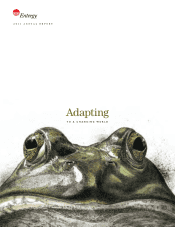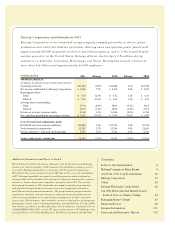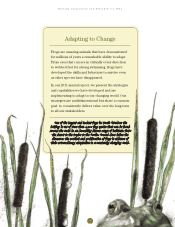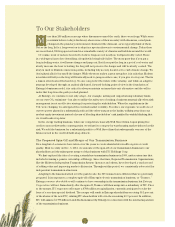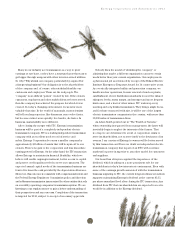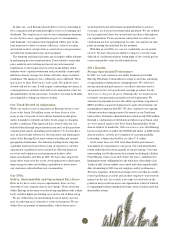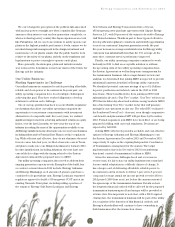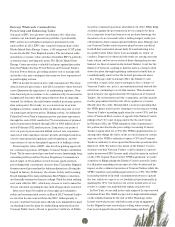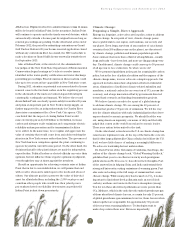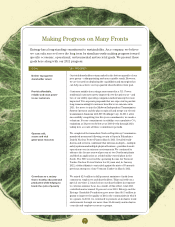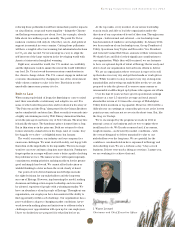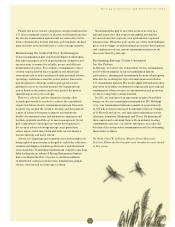Entergy 2011 Annual Report Download - page 4
Download and view the complete annual report
Please find page 4 of the 2011 Entergy annual report below. You can navigate through the pages in the report by either clicking on the pages listed below, or by using the keyword search tool below to find specific information within the annual report.
ore than 200 million years ago when dinosaurs roamed the earth, there were frogs. While some
scientists believe today’s birds may share some of their ancestry with dinosaurs, cataclysmic
changes in the planetary environment eliminated the dinosaur, as we typically think of them.
Not so the frog. In fact, frogs went on to adapt in a spectacular way to environmental change. Today there
are more than 4,900 frog species found in a remarkable variety of climates and habitats around the world.
Of course, most of us have been led to believe frogs are not nearly so well genetically coded. There
is a widespread anecdote describing a frog slowly being boiled alive. The story goes that if you put a
frog in boiling water, it will sense danger and jump out. But if you put the frog in a pot of cool water and
slowly increase the heat to boiling, the frog will not perceive the danger and will be slowly cooked. The
story is used to illustrate numerous points, including why society doesn’t act to curb climate change. We
don’t physically feel or smell the danger. While the story makes a great metaphor, it is only that. Modern
scientists will tell you the frog will frantically seek to jump in either case, if you give it a way out. That is
a lesson often learned the hard way. No one can predict the future with certainty, and while an adaptive
strategy developed through an analytically-based, forward-looking point of view is the foundation of
Entergy’s business model, it is critical to always maintain an immediate exit alternative and the will to
make that leap from the path you had planned.
At Entergy, we continue to not only adapt – for example, setting and outperforming voluntary limits
on our own CO2 emissions – but also to utilize the safety net of exiting a business strategically when risk
management is not an effective strategy for protecting the stakeholders. When the regulations in the
U.K. were changing, we anticipated the eventual market volatility. To reduce our exposure, we sold one of
our two power plants for a substantial profit and the other was put to the banks, walking away from our
modest equity investment instead of years of bleeding shareholders’ cash justified by wishful thinking that
we would make it up later.
In the energy trading business, when our competitors, basically Wall Street firms, began giving free
credit to non-creditworthy counterparties, we refused to compete by warehousing market-induced credit
risk. We sold the business for a substantial profit to a Wall Street firm that subsequently was one of the
firms rescued in the credit default swap debacle.
The Proposed Spin-Off and Merger of Our Transmission Business
It’s a long list of actions we have taken over the years to create shareholder wealth or protect credit
quality. Most recently on Dec. 5, 2011, we announced the spin-off of our transmission business to our
shareholders and the subsequent merger of that business with ITC Holdings Corp.
We first explored the idea of creating a standalone transmission business in 1999, under a structure that
included retaining a passive ownership at Entergy. Since that time, Regional Transmission Organizations,
like the Midwest Independent Transmission System Operator and others, have developed a track record
of adding value and improving market efficiencies. Throughout this period, we consistently advocated for
independent transmission structures.
Adapting to the lessons learned over the past decade, the ITC transaction is different than we previously
proposed. It incorporates a complete spin-off of Entergy’s electric transmission business, or “Transco.”
Entergy common shareholders will continue to have ownership in the transmission business, but Entergy
Corporation will not. Immediately after the spin-off, Transco will then merge into a subsidiary of ITC. Prior
to the merger, ITC expects to effectuate a $700 million recapitalization, currently anticipated to take the
form of a one-time special dividend. The merger will result in Entergy shareholders receiving 50.1 percent
of the shares of the new ITC; existing ITC shareholders will own the remaining 49.9 percent. In addition,
ITC will assume $1.775 billion in indebtedness issued by Entergy in connection with the internal separation
of the transmission business.
To Our Stakeholders
M
2

